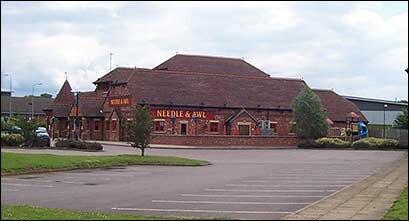|
|
||||||||||||||||||||||||||||||||||||||||||||||||||||||||||||||||||||||||||||||||||||
|
Beerhouses, Hotels and Public Houses
|
||||||||||||||||||||||||||||||||||||||||||||||||||||||||||||||||||||||||||||||||||||
|
||||||||||||||||||||||||||||||||||||||||||||||||||||||||||||||||||||||||||||||||||||
|
Alehouses were the first to sell brewed beverages. During the 1800s there were outdoor and indoor sales at beerhouses. The hotels and inns were the premises where travellers could stay and these had a bar where their residents could take refreshments. Licensing laws were changed to allow the hotels to serve drinks to members of the public. This list is compiled from the Trade Directories, with additions of known properties. Not all would have paid for an entry in a directory.
|
||||||||||||||||||||||||||||||||||||||||||||||||||||||||||||||||||||||||||||||||||||
|
||||||||||||||||||||||||||||||||||||||||||||||||||||||||||||||||||||||||||||||||||||
|
Before piped water came to Rushden in 1906, supply was not reliable and sometimes not fit for drinking, but brewed ale was safe as the fermentation process killed off any bacteria. Most households would in earlier times have done some brewing, but gradually specialists took this over and some started up alehouses. In 1900 Rushden had 7 public houses where ale could be purchased and drunk on the premises. Most would also have an “off” sales counter, where the beer purchased was for drinking off the premises, and was sold by the jug. When bottled beer became widely made so the trade expanded and anyone could buy and then re-sell it. These shops became known as off-licences, because they only sold for drinking off their premises, and they also stocked spirits. It is often forgotten that the growth in places where alcohol could be consumed was counterbalanced by a strong Temperance Movement, often associated with the Baptist and Methodist churches, who saw alcohol and the resulting addiction and drunkenness as a threat to society, and wanted access to it heavily restricted, even banned. However, the numbers of premises selling alcohol continued to grow. Though some old established ones have closed, others have survived and new ones have been added: The Compasses is one of the old public houses, set on the main highway. It used to bear the sign ‘Keep within the Compass’. It was rebuilt in 1904. The Rose and Crown is in the middle of the High Street. The name comes from Tudor times when the houses of York and Lancaster were joined, and was shown on the sign by a crown over a rose which was half red and half white. In 1908 it was sold to Mr. J. Eldworthy for £4,000. The Feathers is also in the High Street. In the 1850s a bus would run from the Feathers to Irchester railway station, which was the nearest to Rushden at that time. The pub was rebuilt in 1937 when the council widened the road and a new complex was built which included the new Feathers Inn and Roses Fashion Centre. Lounge One is the latest name for an old established pub at the north end of the High Street. It was originally called the New Inn, but with the coming of the railways it was changed to the Railway Hotel. It has remained open as a public house, but the name has changed several times and the area around it has been redeveloped. The Oakley Arms, opened in 1881, stands on the cross-roads of Wellingborough Road, Washbrook Road and Irchester Road. It gets its name from the fact that the Oakley Hunt used to meet at the cross roads. It closed at the end of 2008. The King Edward VII stands on the corner of Queen Street and Cromwell Road. It was an originally an off-licence run by Mr. Albert Thomas Mason, and in 1904 he applied for a full licence. This was opposed by the Temperance Society and the neighbours, and his application was refused. However, the licence was later granted to serve that area of the town. The Unicorn, in Grove Road, was opened in 1907. Because it was quite close to the old fire station in Newton Road, it became the ‘home pub’ for the firemen. It was sold recently and is now a private residence but still proudly shows its origin. The Viking was built in 1976 for Charles Wells Ltd., to serve the new Grangeway and Home Farm estate. It was the first public house to be built in Rushden since the Second World War. In 2008 there was a serious fire there, but it was refurbished and opened again later the same year. The Welcome was built in the 1970’s on the Melloway Road estate. It closed in January 2009 but is due to re-open after refurbishment. (May 2009) The Needle and Awl, named after shoemakers’ tools, is on the edge of the town. It was built in 1997 and cost two million pounds. It is one of the new family-restaurant-type of public houses and includes a play area for children. As well as the traditional inns, pubs and alehouses, another leisure institution was born in the wake of the Industrial Revolution: the Working Men’s Club, and other Social Clubs were based on a leisure activity. Rushden has a number of these. |
||||||||||||||||||||||||||||||||||||||||||||||||||||||||||||||||||||||||||||||||||||
|
|
||||||||||||||||||||||||||||||||||||||||||||||||||||||||||||||||||||||||||||||||||||
|
||||||||||||||||||||||||||||||||||||||||||||||||||||||||||||||||||||||||||||||||||||
